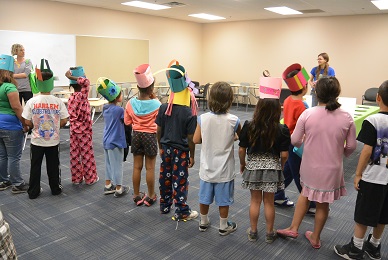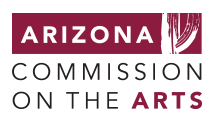“Arts Integration serves a twofold purpose. Firstly, it addresses certain Core Content requirements: in the academic areas and in Art Standards. Secondly, it acts as the building blocks towards the use of the Arts as a teaching tool; one which will increase engagement and enjoyment.”
Throughout June 2014, the Arizona Commission on the Arts presented a pair of exclusive blog series designed to inspire the creativity of Arizona’s educators and to explore the potential for arts integration within Arizona’s College & Career Ready Standards.
In previous entries, Lynn Tuttle, the Arizona Department of Education’s Director of Arts Education, discussed how the Arts Educator could support and enhance English Language Arts & Math curricula. Today, Paul Fisher, Executive Director at Arts Integration Solutions, begins a five-part series wherein he’ll discuss how English Language Arts and Math educators can strengthen their teaching through Arts Integration. New entries will be posted to the azarts417 blog every Tuesday and Thursday through July 1st.
What Is Arts Integration?
A colleague, publishing research on the quality of the existing evidence on the value of arts in education, was denied her choice of a title, which was: “Evidence of Magic.” Apparently her national arts organization sponsors objected to the use of the word magic.
My shock at how profoundly the national arts organization was missing the point, helped me realize that the idea of magic in the classroom is just what we are all attempting.
As Howard Gardner pointed out, “You can’t do interdisciplinary work if you don’t have more than one discipline of expertise.” To this end, Arts Integration seamlessly weaves disciplines together and creates a new avenue of learning that was not there before: as if by “magic.”
Arts Integration is a methodology of teaching teachers simple, discipline-based arts skills so that they will be able to begin the magic of semiotic transmediation[1] in this interdisciplinary context.
There is no creativity without careful development of trust, risk and skills, on the part of the teacher and the student, but above all there will be no progress without playfulness.
 Arts Integration serves a twofold purpose. Firstly, it addresses certain Core Content requirements: in the academic areas and in Art Standards. Secondly, it acts as the building blocks towards the use of the Arts as a teaching tool; one which will increase engagement and enjoyment.
Arts Integration serves a twofold purpose. Firstly, it addresses certain Core Content requirements: in the academic areas and in Art Standards. Secondly, it acts as the building blocks towards the use of the Arts as a teaching tool; one which will increase engagement and enjoyment.
So what is the difference between Arts Education and Arts Integration? Wikipedia offers a brief overview. The John F. Kennedy Center offers many perspectives of Arts Integration as well. Put succinctly, Arts Education is standards-based instruction, by an arts specialist, in any art form: instruction in art for art’s sake. (Again Wikipedia offers an overview.)
While both are academic endeavors, the difference is that Arts Education is using art to teach art and Art Integration uses art as a tool to mediate classroom instruction. Arts Integration merges the arts with core content in the classroom through coordinated instructional practice that engages students in learning.
It is the process of using multi-faceted strategies (see AiS Portal) that have been proven to engage a wide range of learners and advance mastery of curriculum content. It also provides multiple doorways for comprehension, assessment and presentation across the curriculum. And, it allows for multiple learning and teaching modalities that will reach the multiple intelligences of students .At the core of successful Arts Integration is using arts-infused learning to make sure lessons are engaging students in core content.
The Common Core academic standards and the AzCCRS (Arizona College and Career Ready Standards) are especially suited to Arts Integration because they are designed to promote critical thinking. Arts Integration lessons include a learning experience in which students are thinking critically and creating content together.
The Common Core website (corestandards.org) states, “By emphasizing required achievements, the Standards leave room for teachers, curriculum developers, and States to determine how those goals should be reached and what additional topics should be addressed.” Arts Integration steps in to be the answer to “how” and the Arts become the mediator for the “additional topics to be addressed.” In integrating the Arts with a Math or English lesson, for example, the Arts become the learning agent: the route to knowledge.
With the right tools and support, Arts Integration constitutes a valuable pedagogy for teachers to be successful in planning and presenting lessons in the academic subjects. At the same time they will stay on track with their curriculum goals, and create an open learning and teaching environment, which stimulates the classroom environment.
In subsequent posts to this blog we will explore arts strategies in support of learning in math and English, as well as the next generation science standards (nextgenscience.org).
[1] Semiotics is the study of meaning-making. This includes the study of signs and sign processes, indication, designation, likeness, analogy, metaphor, symbolism, signification and communication. Wikipedia
Transmediation–the ways in which a media piece migrates from one medium to another or the act of translating meanings from one discipline to another, which increases students’ opportunities to engage in generative and reflective thinking because learners must invent a connection between the two sign systems, as the connection does not exist a priori. Marjorie Siegel, Canadian Journal of Education / Revue canadienne de l’éducation Vol. 20, No. 4, Cultural Psychology and Semiotics (Autumn, 1995), pp. 455-475
Paul Fisher is the Executive Director at Arts Integration Solutions. From the classroom to the board room, Mr. Fisher has a host of satisfied clients in many differing venues, throughout the US, in Europe, Russia and Africa. He has consulted for Raytheon, INTUIT, Canyon Ranch, Arts For “Border” Children and many other organizations. He teaches creative thinking and gives lectures on a variety of topics. Mr. Fisher has been recognized with two prestigious awards for his years of distinguished service in Arts and Education. Mr. Fisher is a graduate of the University of Birmingham, Great Britain. He has published a variety of books and articles. Mr. Fisher is a dynamic speaker, writer, director, actor, DJ and educator with more than 40 years of experience. Referred to as “the Robin Williams of education,” Fisher always provides a stimulating, hilarious and brain-blasting experience.
Arts Integration Solutions coaches schools to use the arts to teach and engage students and staff in core content learning: integrating the arts into the curriculum and life skills. We provide leadership to “install” a sustainable arts-integrated pedagogy through strategic planning, professional development, classroom modeling and technical support.



